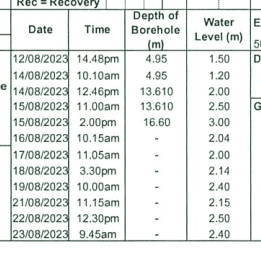chaechaeng
Civil/Environmental
- Apr 23, 2024
- 5
Hi, new engineer here currently assigned to design a shallow foundation for a residential project. One critical factor in this design is the groundwater table level. To determine the GWT level, is it correct to take the average of the water levels recorded?
As attached image below, the sum of the water levels divided by 12 is equal to the value adopted water level for foundation design. Is this approach correct?

Edited: Additional information on the SI works based on
1) Drilling Method: The drilling was carried out using a YWE D90-R rotary boring method.
2) Soil Conditions: The soil consists mainly of sandy silt, with a depth of up to 10.50 meters, underlain by sandstone.
3) Number of Boreholes: A total of 5 boreholes were drilled, with each borehole recording the groundwater table (GWT) level.
4) Site Context: The site is generally flat and underlain by locally prominent sedimentary rocks, including shale, shalestone, slate, phyllite, and some local development of limestone.
5) Load Case Considered / Use of GW Level: The load case being considered includes dead load and live load from residential columns with loads not exceeding 500 kN. The GWT level is being used to determine the appropriate formula for designing the shallow foundation.
As attached image below, the sum of the water levels divided by 12 is equal to the value adopted water level for foundation design. Is this approach correct?

Edited: Additional information on the SI works based on
1) Drilling Method: The drilling was carried out using a YWE D90-R rotary boring method.
2) Soil Conditions: The soil consists mainly of sandy silt, with a depth of up to 10.50 meters, underlain by sandstone.
3) Number of Boreholes: A total of 5 boreholes were drilled, with each borehole recording the groundwater table (GWT) level.
4) Site Context: The site is generally flat and underlain by locally prominent sedimentary rocks, including shale, shalestone, slate, phyllite, and some local development of limestone.
5) Load Case Considered / Use of GW Level: The load case being considered includes dead load and live load from residential columns with loads not exceeding 500 kN. The GWT level is being used to determine the appropriate formula for designing the shallow foundation.
